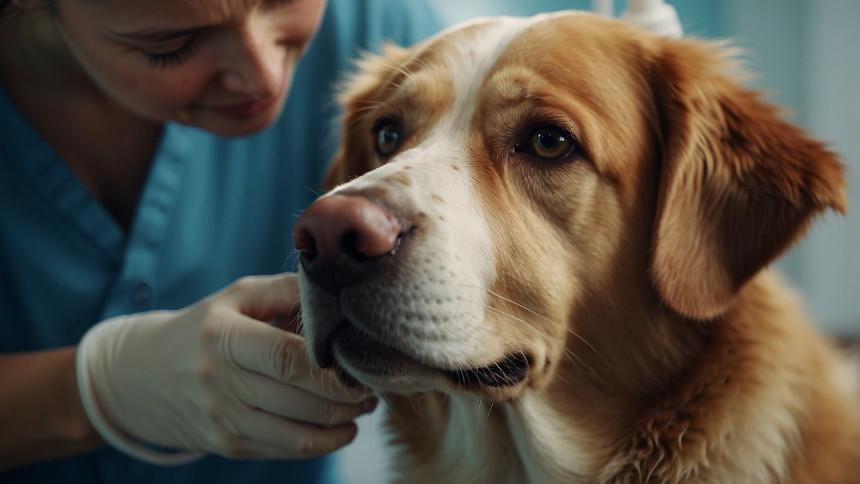When a dog vomits yellow bile, it can be an alarming sight for pet owners, but it is not always a sign of a serious medical condition. The yellow vomit typically consists of bile, a digestive fluid that is produced in the liver, stored in the gallbladder, and released into the small intestine just below the stomach. This type of vomiting may occur when a dog’s stomach is empty for too long, and the bile irritates the stomach lining. On its own, an occasional episode of vomiting may not be cause for concern, and the dog’s next meal is often tolerated well.
Diarrhea in dogs, on the other hand, often indicates irritation or inflammation of the gastrointestinal tract. This can be due to a variety of reasons, including dietary indiscretion, infections, or ingestion of foreign bodies. Consistent with the yellow vomiting, diarrhea can often accompany the vomiting, creating a more complex scenario for the dog’s health. When a dog experiences both vomiting and diarrhea, this can lead to concerns about dehydration and other serious health issues.
Owners should observe their dog’s overall behavior in conjunction with these symptoms. Lethargy, loss of appetite, weakness, or any changes in behavior warrant veterinary attention. Persistent vomiting or diarrhea, especially when the dog cannot keep down food or water, suggests the need for a thorough examination by a veterinarian to determine the underlying cause and to administer appropriate treatment. It’s essential for owners to monitor their pets closely and seek veterinary advice when symptoms are more than just a one-time occurrence.
Understanding Dog Vomiting and Diarrhea
Vomiting and diarrhea in dogs can be symptoms of various underlying problems, ranging from minor to serious. It’s crucial to recognize the common causes, understand how these symptoms link to the anatomy of canine digestive issues, and observe specific signs that indicate when to seek veterinary care.
Common Causes
Infection: Dogs may develop vomiting and diarrhea due to infections by bacteria, viruses, or parasites.
Dietary indiscretion: Consuming inappropriate food or objects can lead to stomach or intestinal upset.
Medications: Certain drugs can irritate the digestive system.
New foods: Introducing new foods suddenly can disrupt their digestion.
Anatomy of Canine Digestive Issues
The canine gastrointestinal tract is susceptible to irritation and inflammation. When this system is disrupted, it can result in symptoms like:
- Vomiting: The expulsion of stomach contents, often including yellow bile, which suggests that the stomach was empty.
- Diarrhea: Frequent, loose, or liquid stools indicate irritation or inflammation of the intestines.
Symptoms to Observe
- Frequency and volume of vomit: Occasional vomiting may not be a concern, but persistent or severe vomiting requires attention.
- Color and consistency: Yellow vomit typically contains bile, indicating an empty stomach or bile reflux.
- Behavior changes: Lethargy, appetite loss, or changes in water consumption can accompany vomiting and diarrhea.
- Physical signs: Dehydration may develop, evidenced by dry gums, sunken eyes, and skin elasticity loss.
Owners should monitor for these symptoms and consider them alongside the behavior and general wellbeing of their dog to decide if veterinary care is needed.
Medical Conditions Associated with Vomiting and Diarrhea
Vomiting and diarrhea in dogs can be symptoms of various medical conditions ranging from mild to severe. It is important for dog owners to recognize that persistent or severe symptoms warrant professional veterinary attention.
Gastrointestinal Disorders
Gastroenteritis: This is an inflammation of the stomach and intestines, often resulting in vomiting, which may appear as yellowish bile, and diarrhea.
Pancreatitis: Inflammation of the pancreas that can cause abdominal pain, vomiting, and diarrhea.
Inflammatory Bowel Disease (IBD): A chronic condition causing inflammation of the gastrointestinal tract, leading to symptoms like vomiting and chronic diarrhea.
Intestinal Obstruction: Foreign bodies can obstruct the intestines, causing vomit and large volumes of diarrhea. This is a critical, life-threatening emergency.
Liver Disease: Liver dysfunction can manifest symptoms including vomiting and diarrhea.
Kidney Disease: Renal issues might also be at the root of vomiting and diarrhea, as toxins build up in the system.
Systemic Diseases
Infections: Viral and bacterial infections, such as parvovirus in puppies and bacterial infections, can cause vomiting and diarrhea in dogs.
Cancer: Some forms of cancer can impact the gastrointestinal system or be systemic, leading to nausea, vomiting, and diarrhea.
Ingestion of Toxins or Foreign Objects
Toxic Substances: Ingesting toxins can cause severe gastrointestinal upset, resulting in vomiting and diarrhea.
Foreign Bodies: Eating inappropriate items (dietary indiscretion) can lead to blockages or irritation in the digestive tract, leading to vomiting and frequent, potentially obstructive diarrhea.
With each of these medical issues, the dog may exhibit additional symptoms such as dehydration, lethargy, loss of appetite, abdominal pain, and weight loss. Prompt veterinary care is crucial to diagnose and treat the underlying cause of these symptoms effectively.
Diagnostic Procedures
When a dog presents with symptoms such as vomiting yellow bile and diarrhea, a veterinarian must conduct a comprehensive diagnostic workup to determine the underlying cause. The approach typically includes a physical examination, various laboratory tests, and in some cases, advanced imaging and endoscopy.
Physical Examination
The veterinarian will start with a thorough physical examination, which provides initial clues to the dog’s health status. They’ll check for signs of dehydration, abdominal pain, and assess the dog’s overall condition. Vomiting and diarrhea are symptoms that can drastically affect a dog’s hydration levels. The vet will also inquire about the pet’s medical history, as bilious vomiting syndrome can be a recurring condition and sometimes a diagnosis of exclusion.
Laboratory Tests
Laboratory tests are crucial in identifying the cause of vomiting and diarrhea. A complete blood count (CBC), biochemical profile, and fecal examination can help rule out infections, parasites, and systemic issues.
- Blood tests: To assess organ function and detect potential infections.
- Fecal examination: To check for parasites or bacterial infections.
These tests may also indicate if the illness could be a reaction to recent medications or new foods introduced to the dog’s diet.
Imaging and Endoscopy
For more detailed internal views, x-rays or ultrasound may be utilized. They can reveal blockages, tumors, or abnormalities in the organ structure.
- X-rays: To detect any foreign bodies or masses within the gastrointestinal tract.
- Endoscopy: Allows direct visualization of the gastrointestinal lining and is helpful for taking biopsies if needed.
In cases where routine diagnostics do not yield sufficient information, a veterinarian may recommend endoscopy to check for inflammation, ulcers, or other specific gastrointestinal diseases.
Performing these diagnostic procedures efficiently facilitates accurate diagnosis and appropriate treatment for dogs experiencing yellow vomiting and diarrhea.
Treatment Options
When a dog is experiencing vomiting yellow bile and diarrhea, it’s essential to address the issue promptly to prevent dehydration and ensure their well-being. Treatment options vary but generally include dietary management, medications and supplements, and in severe cases, hospitalization or surgery.
Dietary Management
The initial step in treating a dog with vomiting and diarrhea is often to modify their diet. Veterinarians typically recommend a temporary shift to a bland, low-fat diet—such as boiled chicken and rice—which is easier to digest. This helps soothe the gastrointestinal tract and provide relief from irritation. Dietary changes should be implemented gradually to allow the dog’s system to adjust.
- Recommended Bland Diet Components:
- Proteins: Boiled chicken or turkey (skinless and boneless)
- Carbohydrates: White rice or boiled potatoes (no butter or spices)
- Hydration: Ensure access to fresh water to prevent dehydration
Medications and Supplements
Vets may prescribe medications and supplements to manage vomiting and diarrhea. Anti-nausea medications can help control vomiting, while deworming might be necessary if parasites are the cause. Supplements such as probiotics can aid in restoring gut health.
- Common Medications:
- Anti-nausea medications
- Anti-diarrheal agents
- Supplements:
- Probiotics
- Electrolytes to balance sodium and potassium levels
It’s crucial to follow the veterinarian’s dosage instructions carefully and to not administer over-the-counter medications without veterinary guidance, as some can be harmful to dogs.
Hospitalization and Surgery
In cases where the dog’s condition does not improve with outpatient treatment, hospitalization may be necessary. This can ensure adequate fluid therapy to combat dehydration and provide monitoring for any underlying conditions that require more intensive treatment. Surgery might be a last resort option if there is an obstruction or other serious condition that cannot be resolved with medication alone.
- Hospitalization:
- Intravenous fluids for dehydration
- Continued medication administration
- Close monitoring of the dog’s condition
- Surgery:
- Reserved for critical cases with obstructions or tumors
- Performed by veterinary surgical specialists
At-Home Care and Prevention
When a dog is vomiting yellow bile and exhibiting signs of diarrhea, at-home care and prevention are centered around careful dietary management, diligent monitoring of the dog’s health, and controlling the dog’s environment to prevent ingestion of harmful substances.
Diet and Nutrition
The first step in addressing yellow vomiting and diarrhea is to assess the dog’s diet. It is crucial to:
- Withhold food for 12-24 hours to allow the gastrointestinal system to rest.
- Provide small amounts of water frequently to prevent dehydration, progressing to an oral hydration solution if needed.
- Reintroduce food with a bland diet such as boiled chicken and rice, starting with small portions.
- Gradually transition back to the dog’s regular diet over a few days, avoiding sudden diet changes that could exacerbate the issue.
Monitoring
Close observation of the dog during this period is vital. Pet owners should:
- Watch for symptoms like loss of appetite, lethargy, or any changes in behavior.
- Check for signs of dehydration, using skin elasticity and checking the gums.
- Monitor the frequency and consistency of vomiting and diarrhea, noting any changes or escalation of symptoms.
Environmental Management
To prevent future incidents, it is important for dog owners to manage the pet’s environment by:
- Ensuring all potential toxins, including toxic foods and plants, are out of reach.
- Supervising the dog to prevent dietary indiscretion, such as eating from the trash.
- Considering proactively using a preventive treatment for parasites, which could be a factor in gastrointestinal distress.
- Observing for risks of bloat, especially in susceptible breeds, by regulating meal sizes and feeding times.
When to Consult a Veterinarian
When a dog starts vomiting yellow bile and experiences diarrhea, it’s critical to know when to seek professional veterinary care. The following subsections detail specific situations that require a veterinarian’s intervention.
Recognizing Emergencies
Emergencies can arise with little warning, and knowing the signs is crucial for a dog’s health. If a dog exhibits persistent vomiting or diarrhea, especially with blood present, it indicates a potentially serious condition. Symptoms such as lethargy, weakness, abdominal pain, or collapsing are alarming and warrant immediate veterinary attention. Dehydration and fever are additional emergency indicators.
Regular Health Checks
Regular health checks by a veterinarian are necessary, even if a dog seems to be recovering from vomiting and diarrhea. These symptoms can be a diagnosis of exclusion, meaning that they could be signs of various underlying conditions. Only a veterinarian can properly diagnose and rule out causes through a physical examination and perhaps diagnostic tests.
Post-Treatment Follow-Up
After initial treatment, a veterinarian should monitor a dog’s recovery. If there’s no substantial improvement within 48 hours, or symptoms worsen, it is imperative to return to the vet for a follow-up. Continuous vomiting or diarrhea can lead to severe complications, including dehydration, which can rapidly deteriorate a dog’s condition. A loss of appetite following treatment may also necessitate a revisit to the veterinarian to assess the effectiveness of the treatment and to adjust it if necessary.
Understanding Medications
When a dog is experiencing vomiting of yellow bile and diarrhea, certain medications can play a critical role in treatment. These medications are typically geared toward combating infection, reducing inflammation, controlling nausea, and restoring electrolyte balance.
Antibiotics and Antiemetics
Antibiotics are prescribed when bacterial infections are identified as the cause of a dog’s gastrointestinal symptoms. Metronidazole is a commonly recommended antibiotic that also possesses antiprotozoal properties, making it effective against a variety of pathogens. Posology is definitive and depends on the dog’s weight and specific condition.
Anti-nausea medications or antiemetics, such as maropitant citrate (Cerenia), are administered to control vomiting. By targeting the vomiting center in the brain, these agents can prevent nausea and the subsequent expulsion of stomach contents.
- Metronidazole:
- Dosage: Tailored to the individual dog’s weight and health status.
- Action: Antibacterial and antiprotozoal.
- Maropitant Citrate (Cerenia):
- Dosage: As prescribed, based on weight and severity of symptoms.
- Action: Antiemetic, effectively reducing vomiting.
Rehydration Therapies
Dehydration resulting from vomiting and diarrhea is a chief concern. Rehydration therapies include oral electrolyte solutions or intravenous fluids, aimed at replenishing electrolytes and maintaining hydration. Oral rehydration often starts with small, frequent amounts to prevent further vomiting.
- Oral Rehydration Solutions:
- Small breeds: 2 to 3 ml every 30 to 60 minutes.
- Medium to large breeds: ⅛ cup to ¼ cup every 30 to 60 minutes.
- IV Fluid Therapy:
- Administered by a veterinarian when oral rehydration is insufficient or not possible.
Anti-Inflammatory Drugs
In the case of gastroenteritis, anti-inflammatory drugs may be used to reduce intestinal inflammation. These should be prescribed by a veterinarian and are often part of a comprehensive treatment plan.
- Canine-Specific NSAIDs:
- Prescribed cautiously to avoid potential side effects.
- Administered under strict veterinary supervision.








